
The Rainy Season (Varsha)

Photography by Otto E. Nelson, Digital image © Asia Society
The Rainy Season (Varsha)
Late 18th century
India, Gujarat or the Deccan
Opaque watercolor on dyed cotton
H. 74 x W. 118 in. (188 x 299.7 cm)
Asia Society, New York: Mr. and Mrs. John D. Rockefeller 3rd Collection, 1979.60
Licensing inquiries
This temple hanging originally hung behind a statue of Krishna and was probably produced for a special festival related to the season and to a specific event in Krishna's life. The eight female figures depicted in profile symmetrical disposed beside the central flowering tree are the cowherdesses (gopis) with whom Krishna often frolicked. They are depicted holding objects such as fans, fly whisks, and lamps that would have been offered to the statue of Krishna. The cows tended by Krishna and his consorts are shown at the bottom of the composition. At the top of the painting, the sun and moon are shown in a dark band of color that represent thunder clouds, indicating that the scene takes place during the rainy season. This pichhavi represents Varsha, the rainy season, as indicated by the darkened band of thunder clouds at the top. The eight gopis stand facing inwards at two groups of four, in attendance on Krishna who is not depicted but whose image would have stood on an altar in front of the hanging. Peacocks perch in the outer two trees and a number of smaller birds in flight enliven the otherwise rather static composition. Tended by gopas (cowherds), two rows of cows with calves stand below the gopis. The river Jumna with fish, turtles, crabs, and other water creatures swimming among lotuses is shown at the bottom, recalling Krishna's birth place, the village of Gokul on the Jumna River opposite the city of Mathura. The sun and the moon are both visible in the thunder clouds at the top and divinities in baggy pantaloons on either side witness the scene and rain down flowers which diaper the background. Gopis bearing offerings appear within medallions around the border. The pichhavi was constructed of four large, vertical panels of cotton of equal size, and the seams are clearly visible. Although there is some abrasion of the pigment along the seams from folding -- for storage in chests when not in use -- the hanging is in remarkably good condition.
